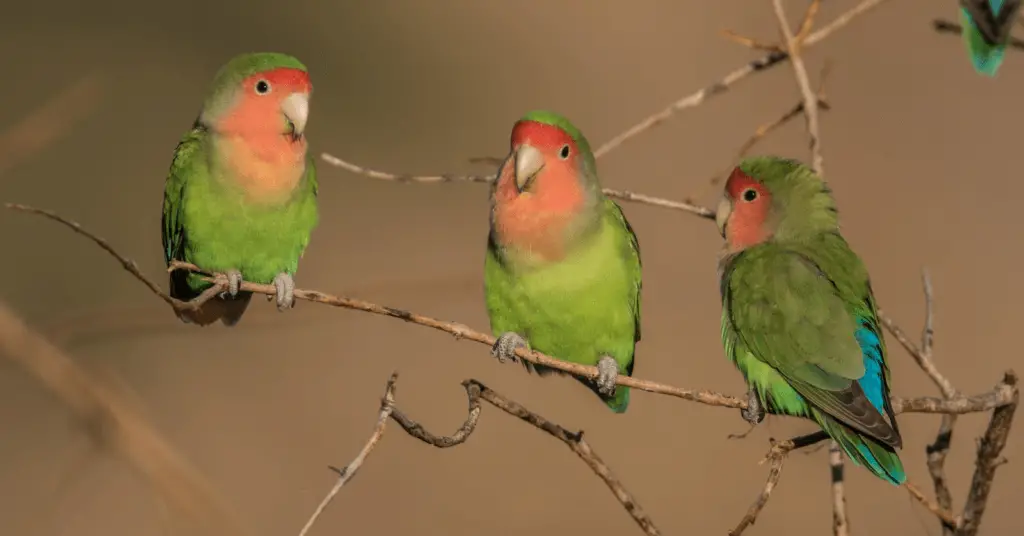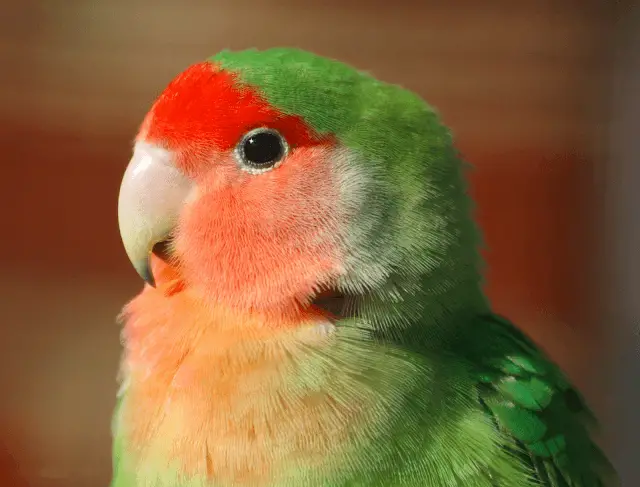
Peach faced lovebird baby: Legal regime: Not listed, free detention not subject to quotas
Order: Psittaciformes Famille: Psittacidae
Sex: No sexual dimorphism
Phenotype:
- White eye circle close
- White beak
- There are many phenotypic mutations
Caractère: ideal bird for beginners, even if it can be quarrelsome, especially with other species or when introducing a new individual Weight: 30 g
Rosy faced parrot
Lovebirds are magnificent domestic birds with multiple bright colors and shiny plumage. Easy to educate and raise, they enjoy living as a couple, as their name suggests.
Of a docile and affectionate character, they like the presence and the caresses of humans, but also the calm. On the other hand, they are playful and clever little animals who can quickly learn to get out of their cage. Who are they?
How to raise them at home? Discover them in this complete file!
Lovebirds are agile, dynamic, and live animals that enjoy climbing up their cage with their powerful legs and beak and flying. However, they especially like to walk on the ground in search of their food.
These birds also tend to stretch after rest. To do this, they extend a leg and a wing on one side, swinging them from front to back, before moving to the other side. When they stand on one leg, they feel good and safe. They can sleep in this position, hiding their beak behind their backs. On the other hand, if they do the same while standing on their two legs, it is because they are sick. It is therefore urgent to consult the veterinarian.
Lovebirds are yawning birds, that’s completely natural for them. On the other hand, if they yawn too often, they may lack fresh air; it is, therefore, preferable to ventilate the room.
These birds groom frequently. For several hours each day, they clean their plumage in smooth
The Lovebirds who are they?
Lovebirds are magnificent birds with plumage rich in color and form the Parrot family. In the wild, they live in tropical Africa, including the island of Madagascar. These birds which domesticate themselves well measure 12 to 16 cm for a weight oscillating between 40 and 60 g.
If there are several species distinguished by their brightly colored plumage, they all have a powerful beak and a beautifully rounded tail. Here are the best known:
The Rosy-throat: this inseparable species has a pink head and blue and green plumage on the rest of the body.
The Fischer: he is recognizable by the white ring that surrounds his eyes and by the very sharp sounds that he is the only one to produce.
The Masked Lovebird: This has green wings, yellow feathers, an orange beak, and an eye-ring.
As the name suggests, the lovebird can only live in a couple, which is why it is not recommended to adopt only one. The animal risks are being wasted.
Recognizing a male from an inseparable female is difficult since these birds have no external organs. However, there are two methods of distinction. One is to observe the pelvic bones, which are larger in the female than in the male, but reliability is questionable depending on the species of lovebirds. For a reliable result, there remains the DNA test to be carried out by the veterinarian.

The choice of the couple is important because not all lovebirds get along well. Indeed, age is an important criterion. If you place a young bird with an older one, they may kill each other quickly.
For beginners, we recommend the pink-faced species, the masked and the Fischer, which are easier to educate and satisfy. Your choice may lie in the beauty of the colors of the plumage with which each species is adorned.
How to install your lovebirds at home?
SOURCE:Birds And Animals Planet
Lovebirds are calm and loving domestic birds. They like tranquility and staying in a soothing, non-noisy room. In addition, they like the company, to be caressed, and that you speak to them, always with gentleness.
It is very easy to tame them, even to teach them a few simple words to repeat. On the other hand, always be delicate with them, because the slightest violence marks them forever and they will remain fearful, distant, or aggressive towards you.
In terms of care, the disease most often affects the beak and claws of lovebirds. Go to the veterinarian at the slightest anomaly.
It is advisable to cut them from time to time on the tip of the beak when it is too long and the nails. However, entrust this task to your veterinarian, as cutting is extremely delicate due to the proximity of blood vessels. Finally, if scales form on the legs, there is a cream treatment to relieve them.
Lovebirds need to be treated regularly for pests. Ask your veterinarian for advice on the proper treatment of the plumage.




















